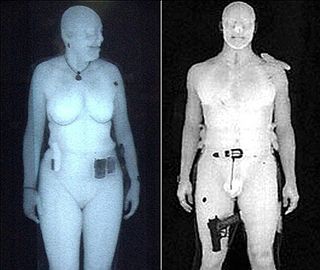How Much Radiation Are You Exposed To During a Cross-Country Flight?

Your Thanksgiving flight to Grandma's house now includes a full-body dose of X-ray radiation from the new security scanners at many airports. You'll also be hit with a hearty serving of cosmic rays during your flight. But is it enough to make you glow green?
Although the amount of radiation absorbed during a flight depends on the plane's altitude and latitude and the current solar activity and weather conditions, the typical New York City-to-Los Angeles trip in a commercial airplane exposes a person to about 2 to 5 millirem (mrem) less than half the dose received from a chest X-ray (10 mrem), according to the U.S Environmental Protection Agency. Rems are a measurement of the biological effect from exposure to radiation.
To put this in perspective, the U.S. Nuclear Regulatory Commission estimates that the average American absorbs 620 mrem a year. About half of that yearly dose comes from natural "background radiation" constantly present in the environment and raining on us from outer space. Higher elevations are hit with more cosmic rays because there is less atmosphere above them to deflect the constant blow of background radiation. Similarly, flying in a plane exposes people to a higher dose of radiation than if they'd traveled by car.
The backscatter X-ray technology being introduced at Transportation Security Administration stations in airports across the country gives off a dose of 10 microrem (mcg), or 0.001 mrem, according to the TSA. So while you're in the plane that's flying cross-country, you're receiving between 2,000 and 5,000 times as much cosmic radiation as you were subjectedto in order to board the plane. Even if you combine those two doses, it is only about1/200th of what you normally receive in a year.
According to Food and Drug Administration standards, no individual who is scanned before flight s is allowed to receive more than 25 mrem in a 12-month period. But there's little chance anyone, even a pilot, would reach that threshold: Doing so would take 25,000 scans in one year.
[polldaddy title="Do airport security scans bother you?" poll="4099285"]
However, some researchers argue that a single backscatter X-ray scan gives a person a larger dose than the TSA claims.
Sign up for the Live Science daily newsletter now
Get the world’s most fascinating discoveries delivered straight to your inbox.
David Brenner, chairman of the department of medicine at Columbia University, discussed the topic at the Congressional Biomedical Research Caucus when the TSA began rolling out backscatter technology in airports. Brenner said the dosage released by the scan is indeed small, but not as small as TSA would have us think.
The number given is what the whole body receives on average. However, the whole body isn't actually receiving the radiation exposure. The skin on the scalp receives 20 times the average dose that is typically quoted by TSA and throughout the industry. It's still a low dose, but it's much more than what's usually said.
Those worried about the 0.001 mrem that a person receives from backscatter airport security scans each way on a round-trip should consider that a person who smokes five cigarettes a day inhales about 1,325 mrem a year more than half the radiation amount absorbed during a CAT scan, according to the office of Health, Safety and Security.
Got a question? Email it to Life's Little Mysteries and we'll find an expert who can crack it.
Follow Remy Melina on Twitter @RemyMelina
Most Popular

